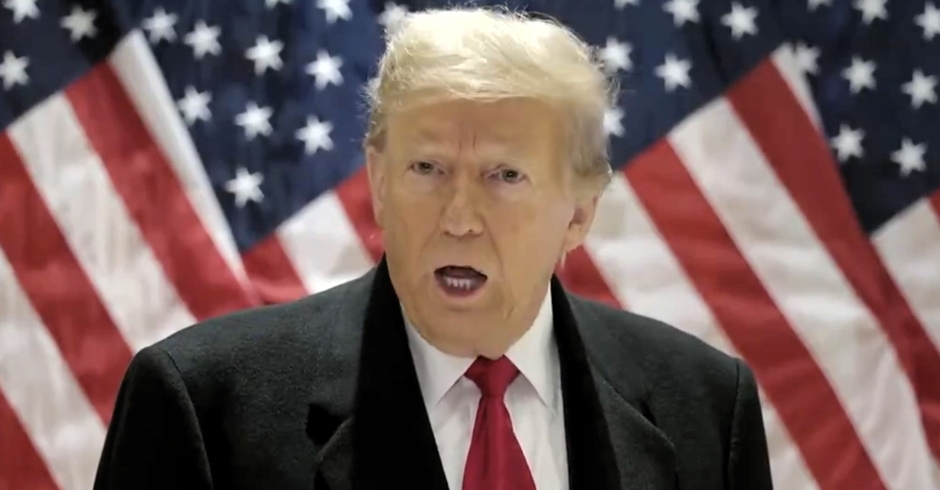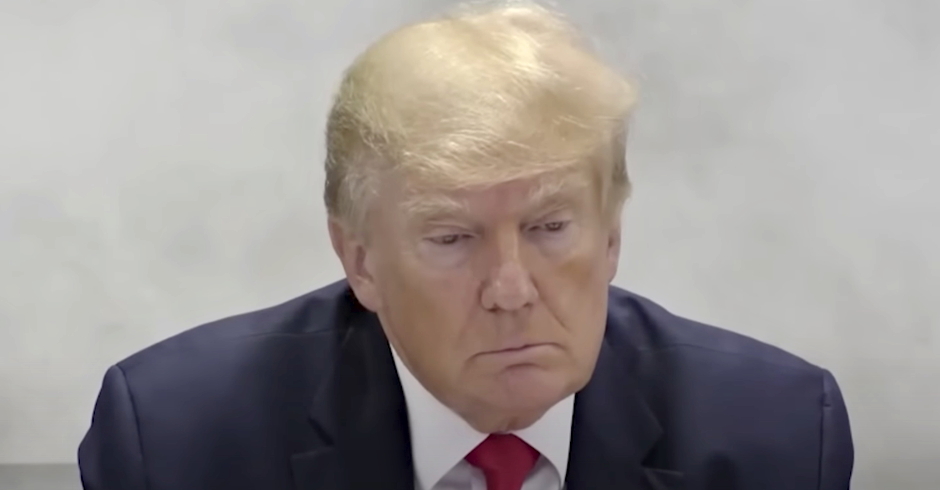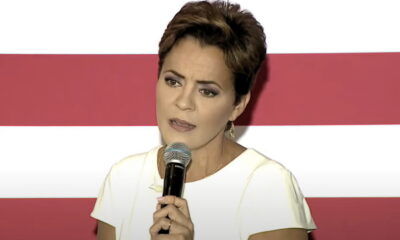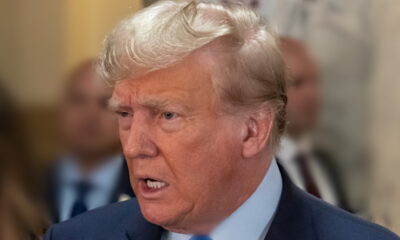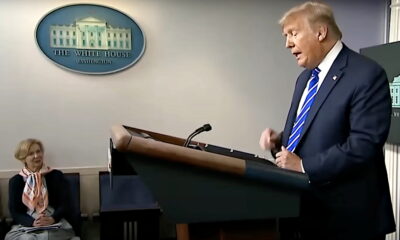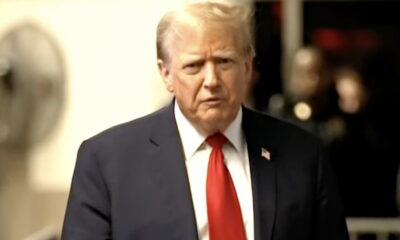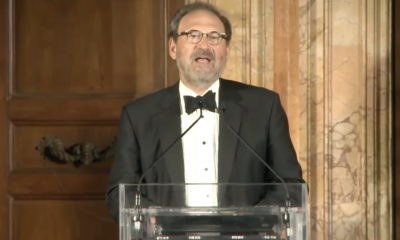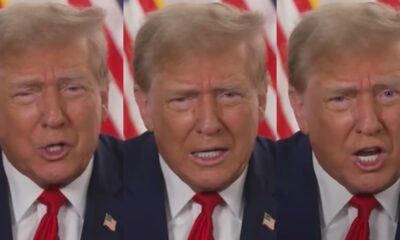Watch: Hillary Clinton Speaks At The 2012 International AIDS Conference
U.S. Secretary of State Hillary Clinton spoke yesterday at the 2012 International AIDS Conference in Washington, D.C. and announced the United States is donating $80 million to help poor countries end new AIDS infections — a portion of the Obama administration’s global goal of an AIDS-free generation. “The United States is committed and will remain committed to achieving an AIDS-free generation. We will not back off, we will not back down, we will fight for the resources necessary to achieve this historic milestone,” Secretary Clinton told the audience, to applause.
READ:Â AIDS Vaccine Possible Before End Of This Decade, HIV Scientist Says
“Let me begin by defining what we mean by an AIDS-free generation. It is a time when, first of all, virtually no child anywhere will be born with the virus. Secondly, as children and teenagers become adults, they will be at significantly lower risk of ever becoming infected than they would be today no matter where they are living. And third, if someone does acquire HIV, they will have access to treatment that helps prevent them from developing AIDS and passing the virus on to others. So yes, HIV may be with us into the future until we finally achieve a cure, a vaccine, but the disease that HIV causes need not be with us.”
Clinton added, “the United States has added funding for nearly 600,000 more people since September, which means we are reaching nearly 4.5 million people now and closing in on our national goal of 6 million by the end of next year.”
Opening with, “We are so pleased to have you all finally back here,” the Secretary alluded to a two-decade boycott the Conference had waged against the U.S., for its travel ban on HIV-positive individuals, lifted under President Obama.
READ:Â 25 Years Later, International AIDS Conference Returns To U.S. After Lift Of HIV Travel Ban
https://youtube.com/watch?v=9bnVNd4G9Ks%3Fversion%3D3%26hl%3Den_US
The full text of Secretary Clinton’s speech at the 19th Annual International AIDS Conference, which runs just over 30 minutes, is below:
Good morning, and – (applause) – now, what would an AIDS conference be without a little protesting? We understand that. (Applause.) Part of the reason we’ve come as far as we have is because so many people all over the world have not been satisfied that we have done enough. And I am here to set a goal for a generation that is free of AIDS. (Applause.) But first, let me say five words we have not been able to say for too long: “Welcome to the United States.†(Applause.) We are so pleased to have you all finally back here.
Â
And I want to thank the leaders of the many countries who have joined us. I want to acknowledge my colleagues from the Administration and the Congress who have contributed so much to the fight against AIDS. But mostly, I want to salute all of the people who are here today who do the hard work that has given us the chance to stand here in 2012 and actually imagine a time when we will no longer be afflicted by this terrible epidemic and the great cost and suffering it has imposed for far too long. (Applause.) On behalf of all Americans, we thank you.
But I want to take a step back and think how far we have come since the last time this conference was held in the United States. It was in 1990 in San Francisco. Dr. Eric Goosby, who is now our Global AIDS Ambassador, ran a triage center there for all the HIV-positive people who became sick during the conference. They set up IV drug drips to rehydrate patients. They gave antibiotics to people with AIDS-related pneumonia. Many had to be hospitalized and a few died.
Even at a time when the world’s response to the epidemic was sorely lacking, there were places and people of caring where people with AIDS found support. But tragically, there was so little that could be done medically. And thankfully, that has changed. Caring brought action, and action has made an impact.
The ability to prevent and treat the disease has advanced beyond what many might have reasonably hoped 22 years ago. Yes, AIDS is still incurable, but it no longer has to be a death sentence. That is a tribute to the work of countless people around the world – many of whom are here at this conference, others who are no longer with us but whose contributions live on. And for decades, the United States has played a key role. Starting in the 1990s under the Clinton Administration, we began slowly to make HIV treatment drugs more affordable, we began to face the epidemic in our own country. And then in 2003, President Bush launched PEPFAR with strong bipartisan support from Congress and this country began treating millions of people.
Today under President Obama, we are building on this legacy. PEPFAR is shifting out of emergency mode and starting to build sustainable health systems that will help us finally win this fight and deliver an AIDS-free generation. It’s hard to overstate how sweeping or how crucial this change is. When President Obama took office, we knew that if we were going to win the fight against AIDS we could not keep treating it as an emergency. We had to fundamentally change the way we and our global partners did business.
So we’ve engaged diplomatically with ministers of finance and health, but also with presidents and prime ministers to listen and learn about their priorities and needs in order to chart the best way forward together. Now I will admit that has required difficult conversations about issues that some leaders don’t want to face, like government corruption in the procurement and delivery of drugs or dealing with injecting drug users, but it has been an essential part of helping more countries manage more of their own response to the epidemic.
We’ve also focused on supporting high-impact interventions, making tough decisions driven by science about what we will and will not fund. And we are delivering more results for the American taxpayer’s dollar by taking simple steps – switching to generic drugs, which saved more than $380 million in 2010 alone. (Applause.)
And crucially, we have vastly improved our coordination with the Global Fund. Where we used to work independently of each other, we now sit down together to decide, for example, which of us will fund AIDS treatment somewhere and which of us will fund the delivery of that treatment. That is a new way of working together for both of us, but I think it holds great results for all of us. (Applause.) Now all of these strategic shifts have required a lot of heavy lifting. But it only matters in the end if it means we are saving more lives – and we are.
Since 2009, we have more than doubled the number of people who get treatment that keeps them alive. (Applause.) We are also reaching far more people with prevention, testing, and counseling.
And I want publicly to thank, first and foremost, Dr. Eric Goosby, who has been on the front lines of all this work since the 1980s in San Francisco. (Applause.) He is somewhere in this vast hall, cringing with embarrassment, but more than anyone else, he had a vision for what PEPFAR needed to become and the tenacity to keep working to make it happen. And I want to thank his extraordinary partners here in this Administration, Dr. Tom Frieden at the Centers for Disease Control and Dr. Raj Shah at USAID. (Applause.)
Now, with the progress we are making together, we can look ahead to a historic goal: creating an AIDS-free generation. This is part of President Obama’s call to make fighting global HIV/AIDS at home and abroad a priority for this administration. In July 2010, he launched the first comprehensive National HIV/AIDS Strategy, which has reinvigorated the domestic response to the epidemic – especially important here in Washington D.C., which needs more attention, more resources, and smarter strategies to deal with the epidemic in our nation’s capital.
And last November, at the National Institutes of Health, with my friend Dr. Tony Fauci there, I spoke in depth about the goal of an AIDS-free generation and laid out some of the ways we are advancing it through PEPFAR, USAID, and the CDC. And on World AIDS Day, President Obama announced an ambitious commitment for the United States to reach 6 million people globally with lifesaving treatment. (Applause.)
Now since that time I’ve heard a few voices from people raising questions about America’s commitment to an AIDS-free generation, wondering whether we are really serious about achieving it. Well, I am here today to make it absolutely clear: The United States is committed and will remain committed to achieving an AIDS-free generation. We will not back off, we will not back down, we will fight for the resources necessary to achieve this historic milestone. (Applause.)
I know that many of you share my passion about achieving this goal. In fact, one could say I am preaching to the choir. But right now, I think we need a little preaching to the choir. And we need the choir and the congregation to keep singing, lifting up their voices, and spreading the message to everyone who is still standing outside.
So while I want to reaffirm my government’s commitment, I’m also here to boost yours. This is a fight we can win. We have already come so far – too far to stop now.
I want to describe some of the progress we’ve made toward that goal and some of the work that lies ahead.
Let me begin by defining what we mean by an AIDS-free generation. It is a time when, first of all, virtually no child anywhere will be born with the virus. (Applause.) Secondly, as children and teenagers become adults, they will be at significantly lower risk of ever becoming infected than they would be today no matter where they are living. (Applause.) And third, if someone does acquire HIV, they will have access to treatment that helps prevent them from developing AIDS and passing the virus on to others.
So yes, HIV may be with us into the future until we finally achieve a cure, a vaccine, but the disease that HIV causes need not be with us. (Applause.)
As of last fall, every agency in the United States Government involved in this effort is working together to get us on that path to an AIDS-free generation. We’re focusing on what we call combination prevention. Our strategy includes condoms, counseling and testing, and places special emphasis on three other interventions: treatment as prevention, voluntary medical male circumcision, and stopping the transmission of HIV from mothers to children.
Since November, we have elevated combination prevention in all our HIV/AIDS work –including right here in Washington, which still has the highest HIV rate of any large city in our country. And globally, we have supported our partner countries shifting their investments toward the specific mix of prevention tools that will have the greatest impact for their people. For example, Haiti is scaling up its efforts to prevent mother-to-child transmission, including full treatment for mothers with HIV, which will in turn, of course, prevent new infections. And for the first time, the Haitian Ministry of Health is committing its own funding to provide antiretroviral treatment. (Applause.)
We’re also making notable progress on the three pillars of our combination-prevention strategy. On treatment as prevention, the United States has added funding for nearly 600,000 more people since September, which means we are reaching nearly 4.5 million people now and closing in on our national goal of 6 million by the end of next year. That is our contribution to the global effort to reach universal coverage.
On male circumcision, we’ve supported more than 400,000 procedures since last December alone. And I’m pleased to announce that PEPFAR will provide an additional $40 million to support South Africa’s plans to provide voluntary medical circumcisions for almost half a million boys and men in the coming year. (Applause.) You know and we want the world to know that this procedure reduces the risk of female-to-male transmission by more than 60 percent and for the rest of the man’s life, so the impact can be phenomenal.
In Kenya and Tanzania, mothers asked for circumcision campaigns during school vacations so their teenage sons could participate. In Zimbabwe, some male lawmakers wanted to show their constituents how safe and virtually painless the procedure is, so they went to a mobile clinic and got circumcised. That’s the kind of leadership we welcome. And we are also seeing the development of new tools that would allow people to perform the procedure with less training and equipment than they need today without compromising safety. And when such a device is approved by the World Health Organization, PEPFAR is ready to support it right away. (Applause.)
And on mother-to-child transmission, we are committed to eliminating it by 2015, getting the number to zero. Over the years – (applause) – we’ve invested more than $1 billion for this effort. In the first half of this fiscal year, we reached more than 370,000 women globally, and we are on track to hit PEPFAR’s target of reaching an additional 1.5 million women by next year. We are also setting out to overcome one of the biggest hurdles in getting to zero. When women are identified as HIV-positive and eligible for treatment, they are often referred to another clinic, one that may be too far away for them to reach. As a result too many women never start treatment.
Today, I am announcing that the United States will invest an additional $80 million to fill this gap. These funds – (applause) – will support innovative approaches to ensure that HIV-positive pregnant women get the treatment they need to protect themselves, their babies, and their partners. So let there be no mistake, the United States is accelerating its work on all three of these fronts in the effort to create an AIDS-free generation and look at how all these elements come together to make a historic impact.
In Zambia, we’re supporting the government as they step up their efforts to prevent mother-to-child transmission. Between 2009 and 2011, the number of new infections went down by more than half. And we are just getting started. Together, we’re going to keep up our momentum on mother-to-child transmission. In addition, we will help many more Zambians get on treatment and support a massive scale-up of male circumcision as well, two steps that, according to our models, will drive down the number of new sexually transmitted infections there by more than 25 percent over the next 5 years. So as the number of new infections in Zambia goes down, it will be possible to treat more people than are becoming infected each year. So we will, for the first time, get ahead of the pandemic there. And eventually, an AIDS-free generation of Zambians will be in sight.
Think of the lives we will touch in Zambia alone – all the mothers and fathers and children who will never have their lives ripped apart by this disease. And now, multiply that across the many other countries we are working with. In fact, if you’re not getting excited about this, please raise your hand and I will send somebody to check your pulse. (Laughter and applause.)
But I know that creating an AIDS-free generation takes more than the right tools, as important as they are. Ultimately, it’s about people – the people who have the most to contribute to this goal and the most to gain from it. That means embracing the essential role that communities play – especially people living with HIV – and the critical work of faith-based organizations. We need to make sure we’re looking out for orphans and vulnerable children who are too often still overlooked in this epidemic. (Applause.)
And it will be no surprise to you to hear me say I want to highlight the particular role that women play. (Applause.) In Sub-Saharan Africa today, women account for 60 percent of those living with HIV. Women want to protect themselves from HIV and they want access to adequate health care. And we need to answer their call. PEPFAR is part of our comprehensive effort to meet the health needs of women and girls, working across United States Government and with our partners on HIV, maternal and child health, and reproductive health, including voluntary family planning and our newly launched Child Survival Call to Action.
Every woman should be able to decide when and whether to have children. This is true whether she is HIV-positive or not. (Applause.) And I agree with the strong message that came out of the London Summit on Family Planning earlier this month. There should be no controversy about this. None at all. (Applause.)
And across all of our health and development work, the United States is emphasizing gender equality because women need and deserve a voice in the decisions that affect their lives. (Applause.) And we are working to prevent and respond to gender-based violence, which puts women at higher risk for contracting the virus. And because women need more ways to protect themselves from HIV infection, last year we invested more than $90 million in research on microbicides. All these efforts will help close the health gap between women and men and lead to healthier families, communities, and nations as well.
If we’re going to create an AIDS-free generation, we also must address the needs of the people who are at the highest risk of contracting HIV. One recent study of female sex workers and those trafficked into prostitution in low and middle income-countries found that, on average, 12 percent of them were HIV-positive, far above the rates for women at large. And people who use injecting drugs account for about one third of all the people who acquire HIV outside of Sub-Saharan Africa. And in low-and middle income countries, studies suggest that HIV prevalence among men who have sex with male partners could be up to 19 times higher than among the general population.
Now over the years, I have seen and experienced how difficult it can be to talk about a disease that is transmitted the way that AIDS is. But if we’re going to beat AIDS, we can’t afford to avoid sensitive conversations, and we can’t fail to reach the people who are at the highest risk. (Applause.)
Unfortunately, today very few countries monitor the quality of services delivered to these high-risk key populations. Fewer still rigorously assess whether the services provided actually prevent transmission or do anything to ensure that HIV-positive people in these groups get the care and treatment they need. Even worse, some take actions that, rather than discouraging risky behavior, actually drives more people into the shadows, where the epidemic is that much harder to fight.
And the consequences are devastating for the people themselves and for the fight against HIV because when key groups are marginalized, the virus spreads rapidly within those groups and then also into the lower-risk general population. We are seeing this happen right now in Eastern Europe and Southeast Asia. Humans might discriminate, but viruses do not.
And there is an old saying that goes: “Why rob banks? Because that’s where the money is.†If we want to save more lives, we need to go where the virus is and get there as quickly as possible. (Applause.)
And that means science should guide our efforts. So today I am announcing three new efforts by the United States Government to reach key populations. We will invest $15 million in implementation research to identify the specific interventions that are most effective for each key population. We are also launching a $20 million challenge fund that will support country-led plans to expand services for key populations. And finally, through the Robert Carr Civil Society Network Fund, we will invest $2 million to bolster the efforts of civil society groups to reach key populations. (Applause.)
Now Americans are rightly proud of the leading role that our country plays in the fight against HIV/AIDS. And the world has learned a great deal through PEPFAR about what works and why. And we’ve also learned a great deal about the needs that are not being met and how everyone can and must work together to meet those needs.
For our part, PEPFAR will remain at the center of America’s commitment to an AIDS-free generation. I have asked Ambassador Dr. Goosby to take the lead on developing and sharing our blueprint of the goals and objectives for the next phase of our effort and to release this blueprint by World AIDS Day this year. We want the next Congress, the next Secretary of State, and all of our partners here at home and around the world to have a clear picture of everything we’ve learned and a roadmap that shows what we will contribute to achieving an AIDS-free generation.
Reaching this goal is a shared responsibility. It begins with what we can all do to help break the chain of mother-to-child transmission. And this takes leadership at every level – from investing in health care workers to removing the registration fees that discourage women from seeking care. And we need community and family leaders from grandmothers to religious leaders to encourage women to get tested and to demand treatment if they need it.
We also all have a shared responsibility to support multilateral institutions like the Global Fund. In recent months, as the United States has stepped up our commitment, so have Saudi Arabia, Japan, Germany, the Gates Foundation, and others. I encourage other donors, especially in emerging economies, to increase their contributions to this essential organization.
And then finally, we all have a shared responsibility to get serious about promoting country ownership – the end state where a nation’s efforts are led, implemented, and eventually paid for by its government, its communities, its civil society, its private sector.
I spoke earlier about how the United States is supporting country ownership, but we also look to our partner countries and donors to do their part. They can follow the example of the last few years in South Africa, Namibia, Botswana, India, and other countries who are able to provide more and better care for their own people because they are committing more of their own resources to HIV/AIDS. (Applause.) And partner countries also need to take steps like fighting corruption and making sure their systems for approving drugs are as efficient as possible.
I began today by recalling the last time this conference was held here in the United States, and I want to close by recalling another symbol of our cause, the AIDS Memorial Quilt. For a quarter-century, this quilt has been a source of solace and comfort for people around the world, a visible way to honor and remember, to mourn husbands and wives, brothers and sisters, sons and daughters, partners and friends.
Some of you have seen the parts of the quilt that are on view in Washington this week. I well remember the moment in 1996 when Bill and I went to the National Mall to see the quilt for ourselves. I had sent word ahead that I wanted to know where the names of friends I had lost were placed so that I could be sure to find them. When we saw how enormous the quilt was covering acres of ground, stretching from the Capitol building to the Washington Monument, it was devastating. And in the months and years that followed, the quilt kept growing. In fact, back in 1996 was the last time it could be displayed all at once. It just got too big. Too many people kept dying.
We are all here today because we want to bring about that moment when we stop adding names, when we can come to a gathering like this one and not talk about the fight against AIDS, but instead commemorate the birth of a generation that is free of AIDS.
Now, that moment is still in the distance, but we know what road we need to take. We are closer to that destination than we’ve ever been, and as we continue on this journey together, we should be encouraged and inspired by the knowledge of how far we’ve already come. So today and throughout this week let us restore our own faith and renew our own purpose so we may together reach that goal of an AIDS-free generation and truly honor all of those who have been lost.
Thank you all very much. (Applause.)
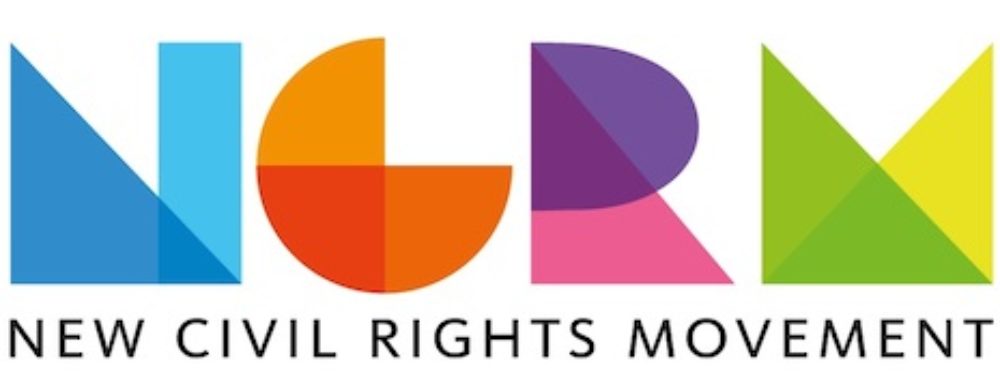
Enjoy this piece?
… then let us make a small request. The New Civil Rights Movement depends on readers like you to meet our ongoing expenses and continue producing quality progressive journalism. Three Silicon Valley giants consume 70 percent of all online advertising dollars, so we need your help to continue doing what we do.
NCRM is independent. You won’t find mainstream media bias here. From unflinching coverage of religious extremism, to spotlighting efforts to roll back our rights, NCRM continues to speak truth to power. America needs independent voices like NCRM to be sure no one is forgotten.
Every reader contribution, whatever the amount, makes a tremendous difference. Help ensure NCRM remains independent long into the future. Support progressive journalism with a one-time contribution to NCRM, or click here to become a subscriber. Thank you. Click here to donate by check.
 |
